Encyclopedia of the Incas
Encyclopedia of the Incas
Edited by
Gary Urton and Adriana von Hagen
ROWMAN & LITTLEFIELD
Lanham Boulder New York London
Published by Rowman & Littlefield
A wholly owned subsidiary of The Rowman & Littlefield Publishing Group, Inc.
4501 Forbes Boulevard, Suite 200, Lanham, Maryland 20706
www.rowman.com
Unit A, Whitacre Mews, 26-34 Stannary Street, London SE11 4AB
Copyright 2015 by Rowman & Littlefield
All rights reserved . No part of this book may be reproduced in any form or by any electronic or mechanical means, including information storage and retrieval systems, without written permission from the publisher, except by a reviewer who may quote passages in a review.
British Library Cataloguing in Publication Information Available
Library of Congress Cataloging-in-Publication Data
Encyclopedia of the Incas / edited by Gary Urton and Adriana von Hagen.
pages cm
Includes bibliographical references and index.
ISBN 978-0-7591-2362-5 (cloth : alk. paper) ISBN 978-0-7591-2363-2 (electronic) 1. IncasEncyclopedias. 2. IncasCivilizationEncyclopedias. I. Urton, Gary, 1946, editor. II. Von Hagen, Adriana, editor.
F3429.E495 2015
909'.0498323dc23
2015006444
 The paper used in this publication meets the minimum requirements of American National Standard for Information SciencesPermanence of Paper for Printed Library Materials, ANSI/NISO Z39.48-1992.
The paper used in this publication meets the minimum requirements of American National Standard for Information SciencesPermanence of Paper for Printed Library Materials, ANSI/NISO Z39.48-1992.
Printed in the United States of America
Introduction
T he Inca Empire was the largest state of the Pre-Columbian New World, greater by far in extent and number of subjects than either Mesoamericas Aztec Triple Alliance or the Maya city-states. The territorial boundaries of the Inca Empire at its height extended almost 5,000 kilometers (3,000 miles) from just north of the present-day border between Colombia and Ecuador; southward along the spine of the Andes through Peru, Bolivia, and northwest Argentina; and down to the Maule River, about 100 kilometers south of Santiago, Chile. The Pacific Ocean formed the western boundary along this vast stretch of territory, while to the east, the frontier generally coincided with the Andean foothills that formed the upper watershed of the Amazon River (in the northern half of the empire) and the Paran River (in the southern half). Within this extensive and ecologically highly diverse territoryfrom the flat, desert, coastal plain eastward, rising to soaring mountains and then dropping sharply down to dense tropical foreststhe Incas exercised an unstable, contested suzerainty over myriad ethnic groups speaking a host of different languages and dialects.
How did a single ethnic group, even one that claimed divine ancestry, subdue the many different peoples who occupied this vast territory and maintain some degree of control over them, even for the empires short life span, ca. AD 14501532? This is the challenge that we take up in the Encyclopedia of the Incas , the first encyclopedia ever produced on this great autochthonous American empire. To meet this challenge, the editors have drawn on 35 highly knowledgeable Inca specialists, each of whom has contributed one or more entries dealing with a topic on which they have special knowledge and expertise. We will have more to say later about the selection of authors and the general rationale for the organization of the encyclopedia.
The purpose of this introduction is two-fold: to provide readers with an understanding of the principal challenges faced by scholars who study Inca civilization and to introduce the Incas to nonspecialists by providing a broad overview of the Incas and their empire through which the specific entries in this encyclopedia may be understood in their larger context.
Sources: The Challenges of Studying a Nonliterate Civilization
Unlike other pristine states of the ancient world (i.e., Mesopotamia, Egypt, China, and the Maya of Mesoamerica), the Incas did not invent a system of writing. They did, however, develop a unique and extraordinarily complex record-keeping system based on quipus knotted-string devices made of spun and plied threads of cotton or camelid (llama and alpaca) fibers. Most of the information these devices retain remains opaque to us today. While we know from postconquest Spanish accounts that quipus were used to register all manner of administrative information for the Inca state (e.g., census and tribute records), and while we are able to interpret the quantities of items knotted into the cords, researchers have not succeeded in determining how the names and identities of the various categories of information were registered. Therefore, unlike researchers investigating any of the other great ancient civilizations, who can read what those people said about themselves, scholars cannot draw on firsthand accounts written by the Incas; rather, Inca specialists are forced to rely on two other sources of information: archaeology and the accounts written by Spaniards following their invasion of Tahuantinsuyu , as the Incas called their land, beginning in 1532.
These sources have advantages as well as problems. Though the archaeological record (e.g., the built environment, such as the remains of houses and roads, and material remains, such as ceramics, metal works, textiles, etc.) bears witness to Inca activities and achievements, they do not speak for themselves. While these empirical resources provide a base of materials for analysis, nonetheless, artifacts must be interpreted, and the analysis of the archaeological record is fraught with uncertainty and ambiguity. What is the absolute age of an object? Why was it produced, how was it used, and when and why was it discarded? These questions and many others open up the past to different viewpoints and interpretations.
Documents about the Incas and their past written by Spaniards in the years following the conquest often have the ring of authority. Caution, however, must always be exercised when reading such accounts. First, since they were usually based on the testimony of informants about events that took place before the conquest, we will never know what really occurred or how the events, forces, and consequences of the conquest may have affected Native testimony in early Colonial times. Second, not only Native Andean informants, but also Spanish authors of Colonial documents may have had reason to skew an account, depending on the interests and motives of the new, European overlords of the Andean world.
For the many reasons cited above, constructing an accurate and reliable picture of life in the Andes before the Spanish conquest is a challenging business. Nonetheless, we believe that the information offered in this encyclopedia provides as knowledgeable, detailed, authoritative, and fair an accounting of Inca realities as can be constructed with the resources available to scholars today.
The overview of Inca civilization that follows draws on both archaeological and documentary (i.e., Colonial era) sources of information. Our purpose in sketching the general outlines of who the Incas were, how they rose to power, and how they established and maintained control within the territory they knew as Tahuantinsuyu (the four parts bound together) is to provide a general framework of the institutions and practices of Inca rule that may facilitate the readers investigation and appreciation of the entries that make up the Encyclopedia of the Incas .
Who Were the Incas and How Did They Rise to Power?
Spanish accounts of what the Incas said about their own origins and nature claim that the Incas ancestors were brought into being by a creator-deity, Viracocha, on the shores of Lake Titicaca. From there the ancestors traveled underground northward from Lake Titicaca and reemerged following the path of the sun and thus establishing their divine connection to Inti, the Sunat a place called Pacariqtambo . Later, the ancestors trekked to a nearby valley where they founded the city of Cuzco, which would become their capital. The ancestor-king, Manco Capac , founded a dynasty of some 11 kings (the number varies in different accounts) who ruled in succession from the founding of Cuzco until the coming of the Spaniards in 1532.
Next page
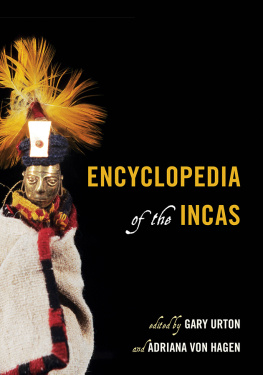
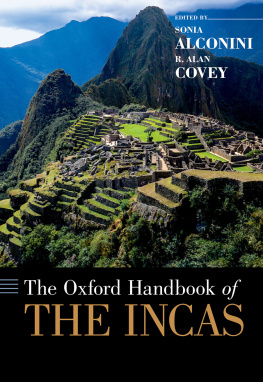
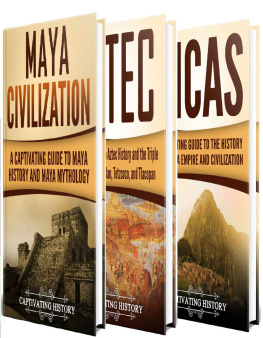
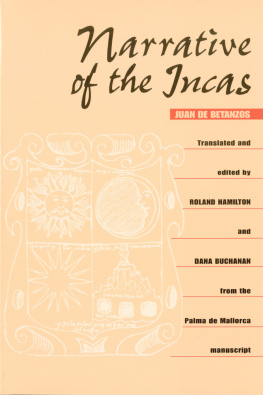

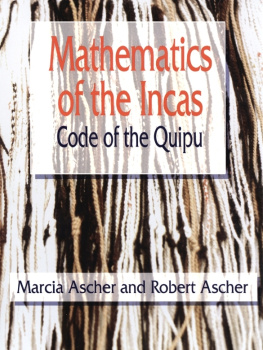
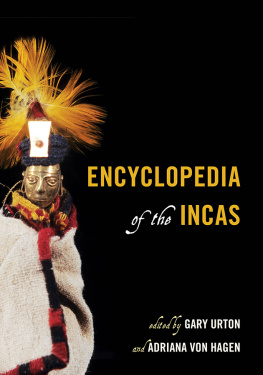
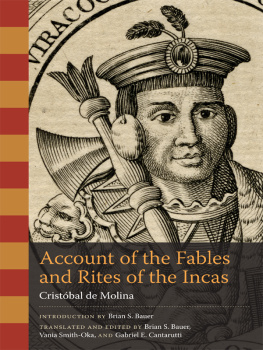
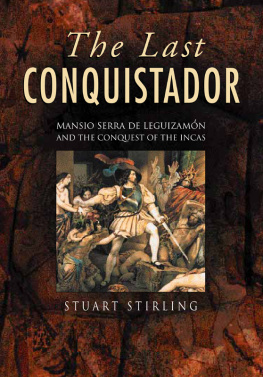
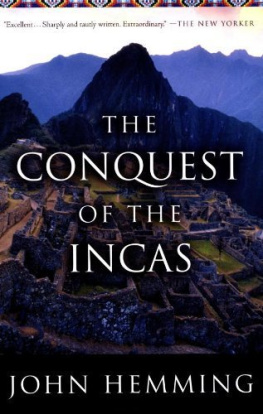
 The paper used in this publication meets the minimum requirements of American National Standard for Information SciencesPermanence of Paper for Printed Library Materials, ANSI/NISO Z39.48-1992.
The paper used in this publication meets the minimum requirements of American National Standard for Information SciencesPermanence of Paper for Printed Library Materials, ANSI/NISO Z39.48-1992.